Emulsion Tube Inspection Guidelines
Example: KTM 640 LC4 Mikuni BST40
Left is new. Right is worn with under 20K miles (32,187 km) (claimed). The green circles represent the boundary of the standard bore diameter. On the worn example, the black area outside the boundary of the circle shows the amount of wear, which measures ~0.0045" (0.11mm) and is due to slide guide wear causing the needle to bear harder on the downstream side of the emulsion tube, and eventually the slide to be constrained by the needle in the emulsion tube rather than by the slide guide. Emulsion tube wear results in an excessively rich mixture, affecting predominantly low rpm operation. The emulsion tube is not something that can conclusively be inspected by eye unless it's really badly worn (you may then be able to see an eccentricity in the bore by rolling the emulsion tube between your fingers). Keep in mind that Mikuni makes needle jets in 0.0002" (0.005 mm) increments, and that such an increment can readily be seen in a change in CO% on the dynamometer. Luckily the relationship between slide guide wear and emulsion tube wear is well established, which renders separate emulsion tube inspection unnecessary.

